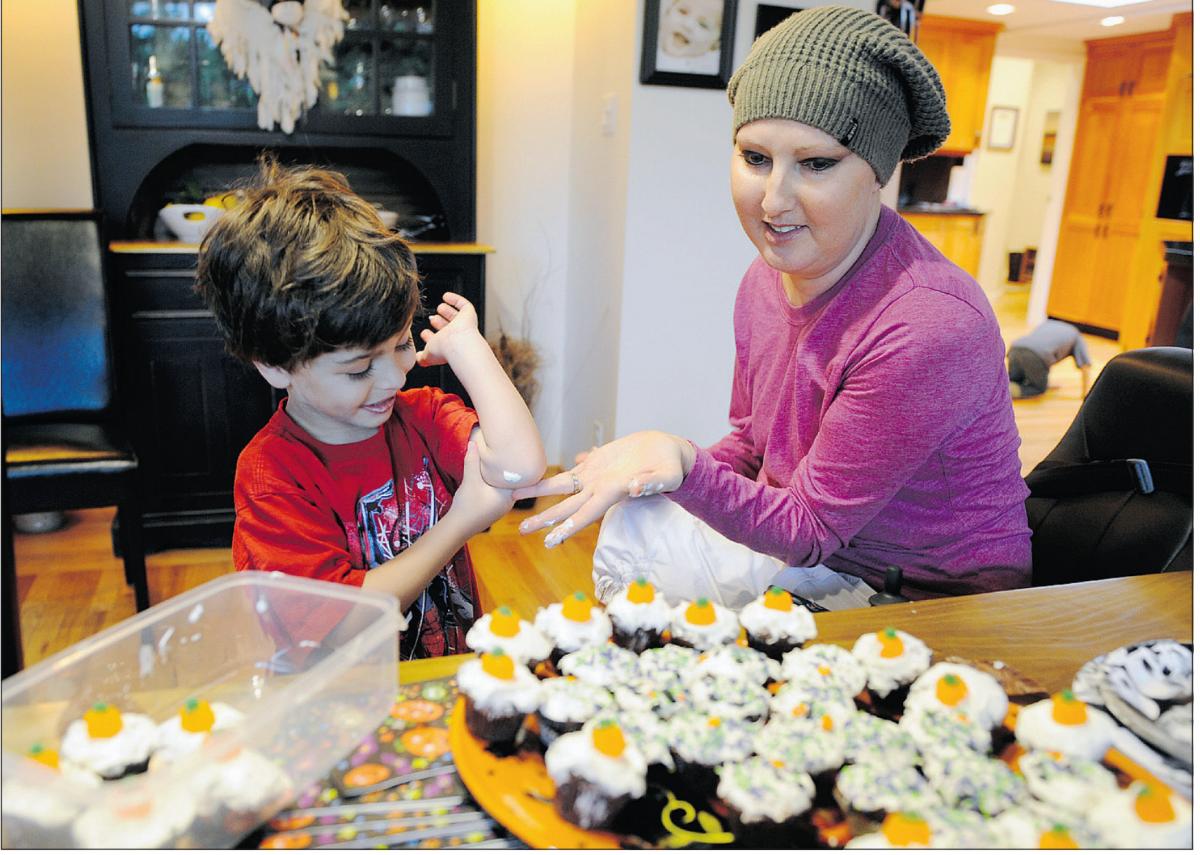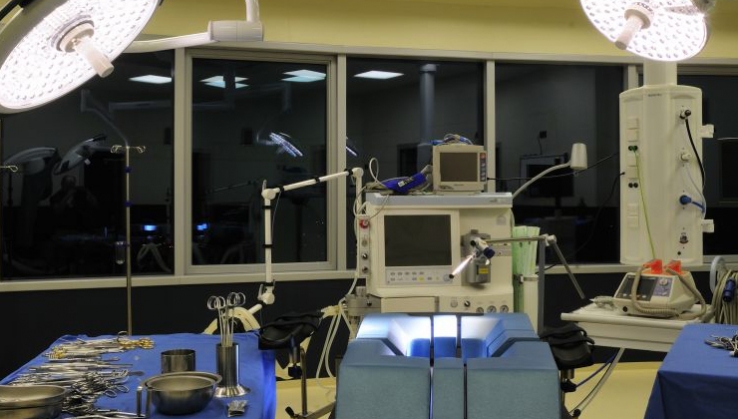
Chelsea Steyns and her son Owen are a mess of smeared icing as they arrange cupcakes for a Halloween party. Chelsea was diagnosed with inoperable brain cancer.
Photograph by: Gerry Kahrmann, PNG , Vancouver Sun
Faced with a terminal diagnosis, Chelsea Steyns decided to take extreme measures.
The family emails read like vacation postcards: jaunts to the beach, the world’s best guacamole, cool rental cars.
But the woman in the pictures is no ordinary tourist. She is 35-year-old Chelsea Steyns, a North Vancouver cancer patient.
The photos were sent from Houston, Texas, where Steyns sought treatment at a controversial clinic for a rare, inoperable brain tumour that has not responded to radiation.
The doctor to whom she turned, Dr. Stanislaw Burzyn-ski, has been branded both a dangerous quack and lauded as a life-saving saint.
This trip, and further treatment in the experimental program Steyns enrolled in, could cost up to $400,000. Her family hopes it will save her life, and the community of North Vancouver – where Chelsea, a mother of four, lives – has rallied in an effort to raise funds for this extraordinarily expensive quest.
With no further treatment options available in B.C., this is her family’s decision: would it be yours?
MEDICAL TOURISM
While an estimated 9,180 patients leave B.C. annually for medical treatment outside Canada, only a handful of those are seeking last-hope oncology care.
Medical tourism is a growing phenomenon. With easily accessible information on the Internet, many who can afford to nip across the border for hip revisions or joint replacements do so rather than join a waiting list.
Others, like Steyns, seek more experimental or unproven procedures.
Multiple sclerosis sufferers have travelled to seek “liberation therapy,” a type of balloon angioplasty that widens the jugular and azygous veins, which has yet to gain approval in Canada.
Although Canadian health authorities don’t keep statistics on patients who seek help outside the system, it is estimated that several thousand Canadian MS sufferers have travelled for this controversial treatment. (After considerable public pressure, the first Canadian study on the procedure was approved and patient recruitment began last week.)
Since 2003, Rick Baker of Timely Medical Alternatives has made a robust living as a medical broker, referring patients for treatments outside the border.
Through Baker, about 500 Canadian clients annually find their way to private hospitals in the U.S., mostly for hip and knee replacements.
Although Baker had one brain cancer client in 2006 who sought treatment at a hospital in New York state after being told he would have to wait eight months for surgery in Ontario, Baker likes to stick with “approved treatments.” For this reason, he doesn’t refer MS or oncology patients.
“I don’t want to be in a position of giving people false hope,” he said.
But for Steyns and her family, hope is everything.
TERMINAL DIAGNOSIS
Shortly after giving birth last January, Steyns, a dance teacher and mother of four, experienced temporary loss of vision and numbness on one side of her body.
After a barrage of tests, she was diagnosed with inoperable PMA, an extremely rare form of pediatric brain cancer hardly ever seen in adults.
She began a round of aggressive radiation therapy.
In August, Steyns learned the radiation had been ineffective. Her devastated family was told their only option was to begin palliative care.
They weren’t ready to accept that Chelsea would die; within a matter of days, they had heard through friends of the Burzyn-ski clinic; a quick search online brought them to his website. Steyns’ sister Emma filled out an online application, sent in a package of Steyns’ medical information, and two weeks later the sisters were on a flight to Texas.
They didn’t balk at controversy surrounding the doctor, or the cost: $35,000 up front and up to $30,000 a month for the targeted gene therapy treatment.
That doesn’t surprise Sarah Sample, patient and family counsellor at the BC Cancer Agency.
How a person handles a difficult diagnosis or prognosis is very individual, but it is common, said Sample, to want to spring into action. “Most people in the world want to do something.”
The younger a person is, the more difficult it can be to accept a terminal diagnosis. “What would drive someone as they decide on how they are going to cope would be their life stage. A young woman may be thinking I must do what I need to do to live longer for my children, for my career, for my dreams,” Sample said.
“I don’t dissuade anyone from taking extreme measures but I would want to ask them questions about the costs and benefits of something. It’s not just the cost of money, it’s the quality of life, the impact on their family, the time and energy and their caregivers’ ability to hold on.”
The BCCA doesn’t track the number of patients who seek oncology treatment outside their umbrella.
But when the doctors they employ try radical approaches, the response is swift.
TREATMENT DECISIONS
Questions about whether the BCCA is too conservative in its treatment protocols were raised earlier this year when Dr. Suresh Katakkar stepped outside of the bounds of B.C.-approved treatments in a last-ditch attempt to save the life of a terminally ill patient.
Katakkar, an American oncologist, had left his practice in Arizona to join the staff at the BCCA in 2011.
With the permission of patient Holly Hill, a 33-yearold Prince George woman with late-stage gastric cancer, Kat-akkar developed an experimental vaccine using her own cells, and gave her a chemo drug traditionally used to fight colorectal cancer.
Katakkar stated that he felt a “moral obligation” to provide this option to Hill, even if he had to step outside the cancer agency’s protocols. He was suspended by the BCCA and returned to the United States, where he continues to practice.
Although Hill died, the family remains unwavering in their support of his efforts to save her life.
“There is more leeway in the private system,” Dr. Katakkar told The Vancouver Sun. “Physicians can prescribe a lot more things even if that treatment has not yet been shown to be scientifically effective, as long as the patient can sign the consent of their own free will.
“It’s not that Health Canada is too conservative in approving drugs,” Katakkar said, there just isn’t enough freedom for doctors to try those drugs in new ways, new combinations.
Katakkar believes patients deserve more say in treatment options. “If the patient is desirous, if the quality of life is still good, they have not lost too much weight and they are not bedridden, and have gone through all conventional treatment, then yes.”
But terminal patients may be vulnerable to ambitious doctors and subject themselves to difficult and painful procedures in the process.
FEELING IN CONTROL
Dr. Chris Daugherty, an oncologist and international authority on medical ethics and end-of-life decision making at the MacLean Centre in Chicago, draws a line between patients pursuing treatments based on “real trials” and Burzynski, who he says is “off the bell-shaped curve 95 per cent of us practice on.”
Daugherty said it would be unfair to compare Burzyn-ski, whose treatments have not been shown in any randomized study to be effective, with doctors conducting clinical trials at more traditional medical centres, but in those cases Daugherty said, “Seeing patients make very difficult decisions we have to make sure we are not taking advantage of them for our own personal gain, fame or fortune. There are conflicts of interest any time research takes place.”
For Steyns and her family, finding an experimental treatment was the only option.
Her brother Dylan and sister Emma, a registered nurse, went to Texas and learned how to administer the treatment.
After several weeks in Texas, the family returned to Vancouver. Now they are working round the clock to care for her, fundraise and help her husband Todd manage their two sets of twins, Owen and Cooper, 4, and Maxine and Cash, nine months. Steyns is a fighter, and a straight shooter: “It’s a pain in the ass, really,” she said in a phone interview. “It’s not fun at all. To have to go that far away and do something so hard, it’s not an approved treatment. I’d rather be here and do something.”
She has had difficulty tolerating the treatment, and is experiencing severe side-effects including dangerously low potassium levels, temporary blindness and severe pain.
An MRI done at Lions Gate Hospital two weeks ago showed the tumour has stopped growing.
“That’s huge,” said Emma who is her sister’s primary caretaker – administering the treatment, helping with pain management and daily blood work.
“Before we went to Texas I was just sad all the time,” Emma said. “Texas really gave us a boost because the nurses and doctors are saying they’ve seen patients come in totally debilitated, as bad as Chelsea, and walk out.” That boost may be what Steyns needs.
“It’s challenging to be told that there isn’t standard treatment that will work; it’s easy to fall into despair in that context,” said Dr. Hal Gunn, co-founder of Inspire, B.C.’s integrative cancer treatment centre.
“Despair and loss of hope can be profoundly disempowering,” said Gunn. “It’s important to recognize that there is so much we don’t know about supporting health and well-being. Very occasionally, people do recover from even advanced cancer. We have to be open to the mystery of it.” Gunn said the majority of people who recover from “incurable” cancer share a range of characteristics that includes having a sense of responsibility and control in their own healing process.
COMMUNITY SUPPORT
Since going to Texas, Emma says, “We have something to focus on and work toward.”
In an extraordinary groundswell that demonstrates, perhaps, the health of the North Vancouver community in which Steyns lives, almost $200,000 has been raised through bottle drives, river-rafting trips, and car washes to support her treatment. Last Saturday, a dance gala in West Vancouver raised thousands more.
“A community coming together to raise money is an expression of love and support, and support is profoundly important to healing,” said Gunn.
Chelsea is buoyed by the gen-rosity of her supporters.
“I want to express a huge thank you to the community for all of their support. It’s totally overwhelming. I just wish I could meet them and hug them all.”
dryan@vancouversun.com
source: http://www.vancouversun.com / Home> News / by Denise Ryan, Vancouver Sun / November 10th, 2012



